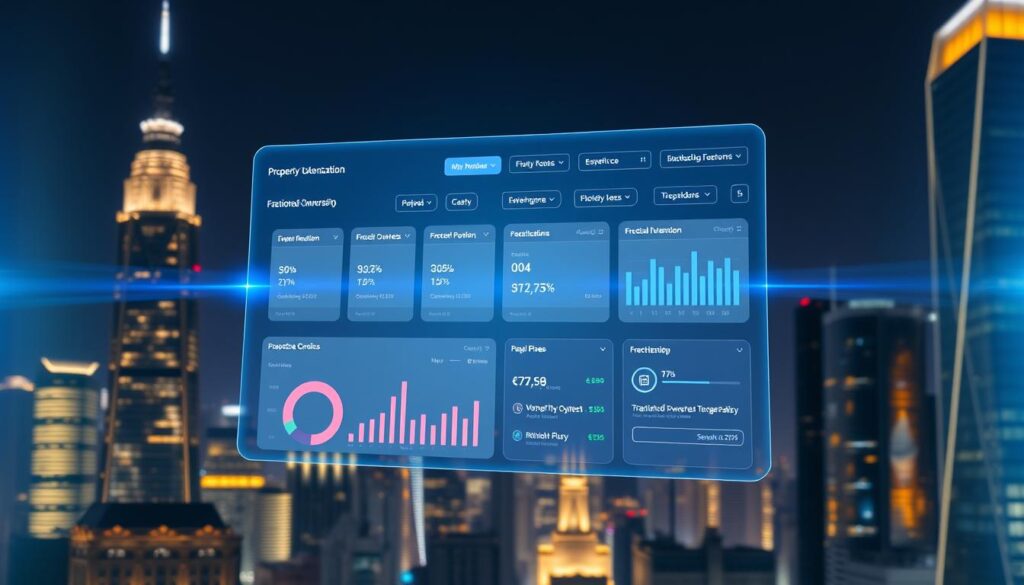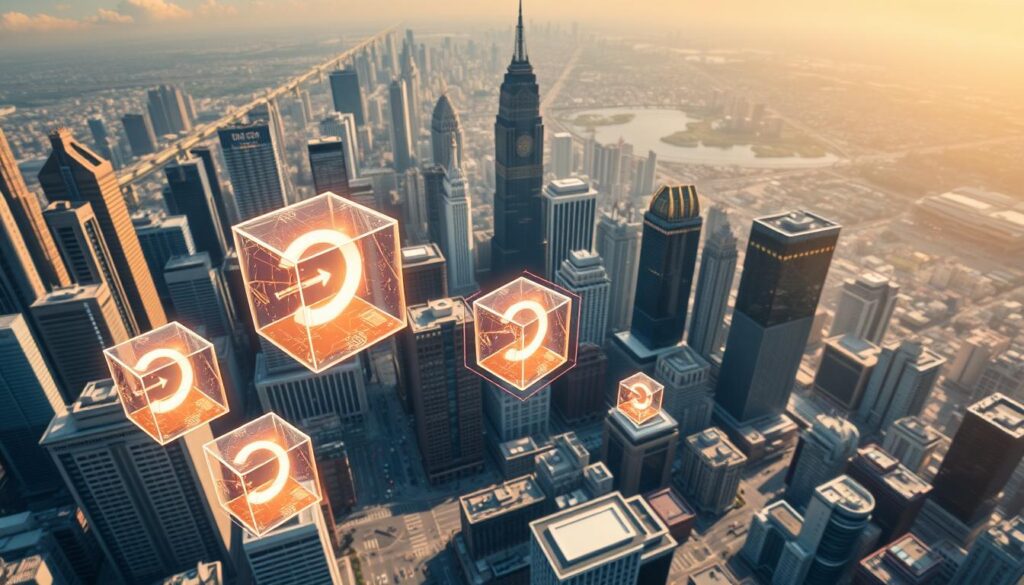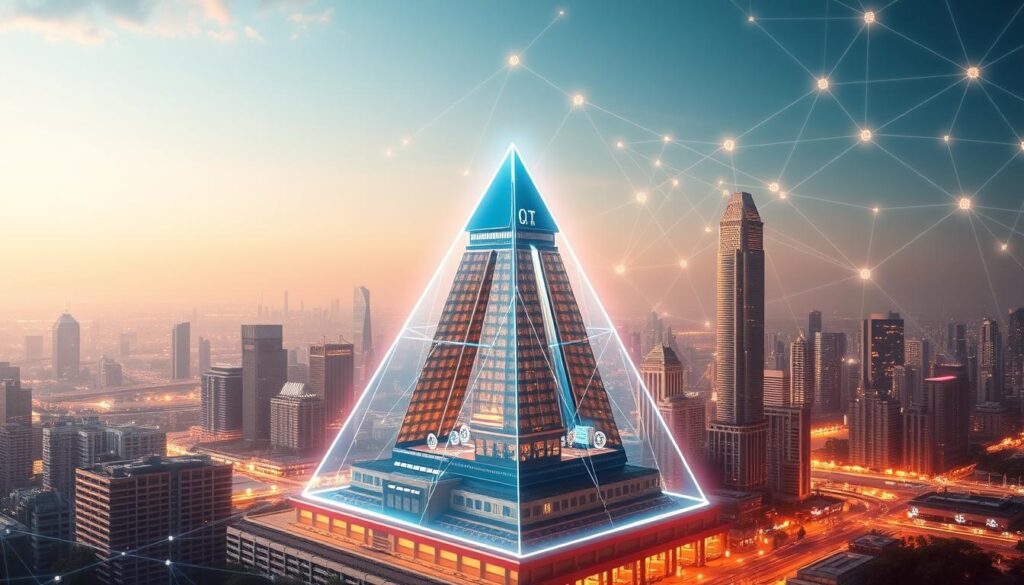The global market for high-value properties faces a big challenge: liquidity. With trillions tied up in physical assets, buying or selling can take months and cost a fortune. But a new wave of innovation is changing everything.
Thanks to blockchain technology, you can now own a piece of premium properties without the usual hassles. Imagine trading shares of a luxury penthouse as easily as stocks. That’s the power of fractional ownership—breaking down barriers and opening doors for more people.
By 2025, experts predict major shifts. Faster transactions, lower fees, and platforms like Polygon leading the charge. Big names like Goldman Sachs are already exploring this space. The question isn’t if this change will happen—it’s how you can be part of it.
Key Takeaways
- The $637.8 trillion property market is becoming more accessible.
- Tokenization cuts costs and speeds up transactions.
- Fractional ownership lets you buy into luxury assets.
- Blockchain and smart contracts make it secure and simple.
- 2025 will be a turning point for this technology.
What Is Asset Tokenization?
High-value properties are no longer out of reach for everyday investors. Thanks to blockchain, you can now own a fraction of a luxury penthouse or a Dubai hotel—no six-figure check required. This shift is powered by tokenization, turning physical assets into tradeable digital tokens.
Breaking Down the Basics
Tokenization splits an asset, like a $10M hotel, into 100,000 tokens at $100 each. Each token represents a share, recorded on the blockchain. Platforms like Ethereum use ERC-721 tokens to ensure transparency. Smart contracts handle payments automatically, cutting paperwork by 30% (IBM).
For example, Lufina’s property NFTs let you buy partial rights for as little as $50. Compare that to traditional deeds, which require full ownership and months of legal processes.
How Tokenization Differs from Traditional Ownership
- Speed: Transactions settle in minutes, not months.
- Liquidity: Sell tokens instantly on secondary markets.
- Access: No need for massive capital upfront.
Regulators like ITSA are setting standards, while Bain & Co predicts an 80% liquidity boost by 2025. The future of ownership is fractional, fast, and fair.
Asset Tokenization: Invest in Real Estate or Art with $100
Fractional ownership is reshaping how people access premium properties and fine art. With just $100, platforms like Homebase let you buy into luxury condos, while RealT offers tokens for commercial spaces at $50 each. No more waiting years to save—start your investment journey today.
How It Works
Automated smart contracts handle everything. When a property earns rent, profits split instantly among token holders. For example, QEDVault’s London office tokens distribute income monthly. No middlemen, no delays.
«By 2035, tokenization could generate $1.3 trillion in efficiency gains.» — IDC
Art Meets Innovation
Platforms like Toko Network tokenize masterpieces. Own a slice of the Mona Lisa or a Warhol. Unlike traditional auctions, you can trade shares 24/7—no waiting for market hours.
| Platform | Minimum Buy-In | Asset Type |
|---|---|---|
| Homebase | $100 | Residential |
| RealT | $50 | Commercial |
| Toko Network | $200 | Fine Art |
Diversify across cities or asset classes. Deloitte’s analysis shows booming markets in Dubai and Singapore. Build a global portfolio, one token at a time.
Take the St. Regis Aspen Resort. Early tokens gained 30% in two years. With SEC-compliant platforms like Securitize, risks are managed transparently.
Unlock value in markets once reserved for the elite. The future is fractional—and it’s here now.
How Real Estate Tokenization Works
Blockchain is rewriting the rules of property ownership, making it faster and fairer. Instead of waiting months for paperwork, deals now close in days—or even minutes. Here’s how technology is changing the game.

The Role of Blockchain in Tokenization
Every tokenized property lives on an immutable ledger. This means ownership records can’t be altered or faked. Platforms like Ethereum and Polygon handle transactions, but with big differences:
| Feature | Ethereum | Polygon |
|---|---|---|
| Speed | 15 TPS | 7,000 TPS |
| Cost | Higher fees | Near-zero fees |
| Use Case | High-value assets | Mass-market deals |
IBM found tokenization cuts closing times from 10 days to 48 hours. Hybrid models blend on-chain speed with off-chain legal checks for full compliance.
Smart Contracts: The Backbone of Tokenized Assets
Smart contracts handle everything automatically. Rent payments? Distributed instantly to token holders. Title transfers? Done in minutes, like Roofstock onChain’s recent $22M deal.
- Security: Biometric logins and multi-sig wallets protect your shares.
- Transparency: Every transaction is public but anonymized.
- Access: 92% of buyers now prefer digital-first deals (NAR).
From due diligence to dispute resolution, blockchain technology removes the middlemen. The result? Lower costs, faster transactions, and a system that works for everyone.
Top Blockchains for Tokenization in 2025
Not all blockchains are created equal for fractional ownership. By 2025, leaders will emerge based on speed, cost, and compliance. Here’s what sets them apart.
Polygon dominates with $0.01 transactions—ideal for micro-investments. Its roadmap targets institutional adoption, partnering with firms like Kraken for real estate tokens. Hybrid L1/L2 solutions could dominate the future.
Solana races ahead with 400ms block times. Need instant trades? This blockchain handles 50,000 transactions per second. But Ethereum’s battle-tested security still wins for high-value deals.
| Feature | Polygon | Solana | Ethereum |
|---|---|---|---|
| Speed (TPS) | 7,000 | 50,000 | 15 |
| Avg. Fee | $0.01 | $0.001 | $5+ |
| Best For | Mass-market | High-frequency | Secure assets |
Tezos stands out with on-chain governance. Its liquid proof-of-stake cuts energy use by 99%—key for eco-conscious investors. Meanwhile, Binance Smart Chain captures Asian markets, while Polkadot’s parachains streamline REITs.
Microsoft and NVIDIA hint at metaverse integrations. Private chains may rise for enterprises. One thing’s clear: scalability wins in 2025.
Leading Asset Tokenization Platforms to Watch
Innovative platforms are transforming how you access high-value opportunities. Whether you’re a seasoned investor or just starting, these tools simplify fractional ownership.
ConsenSys vs. Toko Network: Enterprise Meets Retail
ConsenSys caters to large-scale deals, with Ethereum-based solutions for institutions. Meanwhile, Toko Network focuses on user-friendly interfaces for retail investors. Their IP tokenization lets you own shares in patents or copyrights.
Key differences:
- ConsenSys: Custom smart contracts for Fortune 500 firms.
- Toko: One-click purchases for digital collectibles.
PixelPlex and Securitize: Bridging Old and New
PixelPlex excels at integrating legacy systems with blockchain. Their APIs connect traditional databases to tokenized markets. Securitize, an SEC-registered platform, offers a compliance dashboard for Reg D/Reg S offerings.
«Securitize’s automated workflows reduce onboarding time by 70%.»
| Platform | Focus | Unique Feature |
|---|---|---|
| ConsenSys | Enterprise | High-value asset support |
| Toko Network | Retail | IP tokenization |
| PixelPlex | Integration | Legacy system APIs |
| Securitize | Compliance | SEC-registered transfers |
Other notable names include Harbor for REITs and Polymath’s STO launchpad. Lufina’s public security audits set transparency benchmarks, while tZERO boosts liquidity for secondary trading.
These platforms democratize access, turning once-exclusive assets into tradable shares. The future of ownership is here—and it’s built on trust and technology.
Benefits of Tokenizing High-Value Assets
The future of ownership is flexible, fast, and open to everyone. By digitizing shares of premium properties and collectibles, blockchain removes traditional barriers. Here’s how you gain:

Lower Costs, Higher Liquidity
McKinsey reports a 30% drop in transaction costs with tokenization. Bain & Co adds that markets see an 80% liquidity boost—proven by MERJ Exchange’s 24/7 trading for tokenized shares.
Compare traditional deals (months to close) to blockchain (minutes):
| Feature | Traditional | Tokenized |
|---|---|---|
| Speed | 3–6 months | 48 hours |
| Minimum Buy-In | $50,000+ | $50 |
| Trading Hours | Market hours | 24/7 |
Diversification Made Simple
Own a Monaco penthouse and a Tokyo office in one portfolio. QEDVault’s $50M London building tokens let 500+ investors share profits. Even blue-chip art—like Picasso pieces—is now fractional.
«Goldman Sachs predicts a $1T tokenized market by 2030, driven by democratized access.»
Automation and Transparency
Smart contracts handle tax reporting (via Chainalysis) and compliance (like Harbor’s platform). Dubai’s blockchain land registry cuts fraud by 99%. ESG goals? Tokenized carbon credits track impact in real time.
From REITs to rare art, the benefits are clear: less friction, more transparency, and opportunities for all.
Challenges and Risks of Asset Tokenization
While digital ownership opens new doors, it also brings fresh hurdles to navigate. From shifting regulations to cyber threats, understanding these challenges helps you make smarter moves in this evolving market.
Regulatory Uncertainty
Rules vary wildly by region. The SEC cracked down on unregistered STOs in 2023, while the EU’s MiCA framework aims for harmony. Dubai? It’s a sandbox for innovation. Here’s how key regions compare:
| Region | Approach | Key Requirement |
|---|---|---|
| USA | Enforcement-first | SEC registration for securities |
| EU | Unified framework | MiCA licensing |
| UAE | Pro-innovation | ADGM’s DLT Foundations |
The FATF Travel Rule adds complexity, requiring identity checks for cross-border transactions. PwC predicts clearer global standards by 2026—but for now, compliance is a moving target.
Security Concerns and Solutions
DeFi hacks stole $200M in 2024, and exploits like Poly Network’s $600M breach show smart contracts aren’t foolproof. Yet tools exist to cut risks:
- Fireblocks: Multi-sig wallets with insurance coverage.
- Ledger Vault: Hardware-based custody for institutions.
- Chainalysis: Tracks suspicious activity in real time.
«Title insurance gaps remain the Achilles’ heel of tokenized properties—hybrid legal-tech solutions are critical.»
For peace of mind, new insurance products like Evertas cover digital asset theft. The lesson? Balance innovation with security—always.
Real-World Examples of Successful Tokenization
Imagine owning a piece of a skyscraper or a luxury resort—without needing millions. Platforms like Lufina and projects like The Shard prove it’s possible. Here’s how they’re reshaping ownership for investors worldwide.
Lufina: Democratizing Real Estate Investment
With a $50 entry point, Lufina lets you buy fractions of properties via NFTs. Their audit process is transparent, with quarterly reports published on-chain. Need liquidity? Use your tokens as collateral for loans.
Compare this to traditional deals, where paperwork alone costs thousands. Lufina’s model is simple:
- Own a share of a Dubai villa or Miami condo.
- Earn rental income automatically via smart contracts.
- Trade tokens 24/7 on partnered exchanges.
The Shard: A Skyscraper on the Blockchain
London’s iconic 95-story tower is now partially tokenized. Investors earn dividends from retail and office rentals—paid in stablecoins. The project raised $18M in weeks, proving demand for real-world assets.
«Tokenizing The Shard boosted liquidity by 40%, attracting global investors.»
Other standout examples:
- St. Regis Aspen: Tokens gained 30% post-tZERO listing.
- RealT: Detroit rentals vs. luxury—both thriving.
- MERJ Exchange: Cross-border settlements in minutes.
From skyscrapers to suburban homes, the future of estate ownership is fractional, fast, and fair.
How to Start Investing in Tokenized Assets
Ready to dive into fractional markets? Follow these steps to begin securely. With minimums as low as $50, digital ownership is within reach—if you know where to start.

Step 1: Set Up a Wallet
Choose a non-custodial wallet like MetaMask for full control, or a custodial option (e.g., Coinbase Wallet) for ease. Always back up your seed phrase offline.
Step 2: Complete KYC
Most platforms require ID verification. Expect to submit a photo ID and proof of address. This protects you and the market from fraud.
- Custodial platforms: Handle security for you but limit flexibility.
- Non-custodial: You manage keys—ideal for advanced investors.
Step 3: Pick Your Assets
Diversify across property, art, or commodities. Tools like Zapper.fi track portfolios across chains. Start small—$50–$500 spreads risk.
«Dollar-cost averaging smooths volatility. Allocate 10% monthly to build exposure steadily.»
Tax & Security Tips
Use TurboTax Crypto for reporting. Cold storage (Ledger Nano) safeguards large holdings. Avoid unregulated platforms—stick to SEC-compliant options like Securitize.
With the right platform, you’ll gain access to global opportunities. Just remember: research trumps hype in this fast-moving investment space.
Global Market Access Through Tokenization
Borders no longer limit where your money can work for you. Tokenization turns local properties into global opportunities. Dubai aims to put all real estate on blockchain by 2030, while Singapore’s MAS sandbox tests cross-border deals.
Consider a London-Tokyo investment split. Morning coffee in Shibuya, afternoon dividends from Mayfair—all settled in USDC. Stablecoins like EURT solve FX headaches. No banks, no delays.
Emerging markets shine brightest. Rio apartments and Nairobi malls trade alongside New York penthouses. Deloitte’s guide shows where legal frameworks welcome digital ownership:
| Market | Advantage | Example |
|---|---|---|
| Dubai | Tax-free trading | DMCC Free Zone tokens |
| Singapore | MAS-regulated | Propine’s REIT platform |
| Switzerland | DLT-friendly laws | TokenSuisse vineyards |
«Timezone-agnostic trading could add $17B to emerging market liquidity by 2025.»
The metaverse expands possibilities. Decentraland parcels trade alongside physical assets. Visa’s stablecoin trials hint at future remittance uses—send property shares as easily as Venmo payments.
Asia leads this shift. Hong Kong’s crypto rules and Japan’s Web3 push suggest where investors will focus. Your portfolio can now span the world with unprecedented access.
The Role of Smart Contracts in Fractional Ownership
Behind every tokenized asset lies a smart contract enforcing fairness. These self-executing agreements cut paperwork, speed up transactions, and ensure compliance—all without middlemen. IBM found they reduce closing times from 10 days to 48 hours.
How Smart Contracts Work
Imagine renting out a condo. A smart contract automatically splits income among owners. Homebase uses this for monthly payouts. Escrow conditions? Funds release only when inspections pass.
- Dividends: Distributed instantly via Chainlink oracles.
- Disputes: DAO voting resolves conflicts transparently.
- Upgrades: ERC-3643 allows secure code updates.
«Accord Project templates standardize legal clauses, slashing negotiation time by 60%.»
Security and Compliance
Audits by firms like Quantstamp catch vulnerabilities. Insurance payouts trigger automatically after verifiable events. Compare traditional vs. automated systems:
| Task | Traditional | Smart Contract |
|---|---|---|
| Rent Collection | Manual invoices | Auto-split via USDC |
| Title Transfer | Notary visits | On-chain signatures |
| Tax Reporting | Accountant fees | API-fed records |
From escrow to governance, automation rewrites the rules. The future of ownership is code—and it’s unstoppable.
Future Trends: Where Tokenization Is Headed
Tomorrow’s markets will look nothing like today’s. Gartner predicts $1.3T in efficiency gains by 2030 as technology reshapes ownership. From AI-driven valuations to quantum-resistant ledgers, here’s what’s coming.
AI meets real-world value
Machine learning now appraisals properties in minutes. Zillow’s models analyze 500+ data points—from foot traffic to weather patterns. Expect platforms to integrate these tools by 2026.
Smart buildings go live
IoT sensors tokenize energy usage. Imagine earning when your office space saves power. NVIDIA’s Omniverse already simulates this for Dubai skyscrapers.
| Trend | Impact | Timeline |
|---|---|---|
| AI valuations | ±3% accuracy | 2025-2027 |
| IoT dividends | 5-8% yield boost | 2026+ |
| Carbon credits | New asset class | Live now |
«Interchain settlements via Cosmos IBC will collapse cross-border friction by 2027.»
Money gets smarter
RWA-backed stablecoins could replace 20% of fiat payments. Meanwhile, 14 central banks test CBDCs for property deals. The FedNow-Polygon pilot shows early potential.
Apple Vision Pro changes how we view market opportunities. Tour Tokyo condos in AR before buying shares. But quantum computing threatens today’s encryption—Post-Quantum Crypto standards are already in development.
Regulators are catching up. The EU’s MiCA framework sets a blueprint for global harmony. Social impact tokens also rise, funding green energy projects worldwide.
This isn’t just about finance—it’s about rebuilding systems for a fairer world. The future is transparent, borderless, and open to all.
Why Institutional Investors Are Embracing Tokenization
Major financial players are shifting strategies to embrace digital ownership models. Goldman Sachs’ tokenized fund and BlackRock’s BUIDL initiative highlight this trend. For institutions, blockchain solves three core challenges: liquidity, compliance, and operational costs.
Balance sheets transform when illiquid assets become tradable 24/7. PwC estimates tokenization cuts settlement times by 90%. This lets firms rebalance portfolios faster during market shifts.
«Our digital bond platform reduces counterparty risk while meeting ESG reporting standards.»
ESG benefits drive adoption too. On-chain carbon tracking aligns with disclosure rules. JPMorgan’s Onyx platform shows how automated audits simplify compliance.
| Institution | Tokenized AUM | Growth (2023-24) |
|---|---|---|
| BlackRock | $3.1B | 290% |
| Goldman Sachs | $1.8B | 175% |
| BNY Mellon | $950M | 210% |
Synthetic assets create new strategies. Institutions can hedge positions without physical ownership. Chainlink oracles provide real-time pricing for complex derivatives.
Pension funds are next. California’s CalSTRS is testing tokenized treasuries. With custody solutions from Fireblocks and Ledger, risk management meets institutional standards.
The future? A blend of TradFi reliability and DeFi efficiency. As regulations clarify, expect more trillion-dollar players to enter this space.
FAQ
What is fractional ownership?
Fractional ownership lets you buy a small share of high-value properties like real estate or art. Instead of paying full price, you invest a fraction of the cost, making it more affordable.
How does blockchain technology support tokenized assets?
Blockchain ensures secure, transparent transactions by recording ownership on a decentralized ledger. This eliminates fraud and speeds up deals without middlemen.
What are the benefits of investing in tokenized real estate?
You get lower entry costs, faster transactions, and global market access. Plus, smart contracts automate payments and compliance, reducing paperwork.
Conclusion: The Tokenized Future of Investing
The way we own and trade high-value items is changing forever. What once required deep pockets now starts with small steps, thanks to fractional markets.
Compare 2020’s paperwork-heavy deals to today’s instant settlements. Institutions and everyday investors now share equal opportunities, with platforms like QEDVault bridging the gap.
Security has evolved too. Regulators and tech firms now work together, making digital investment safer than ever. Diversify across real estate, renewables, or even royalties.
New asset classes emerge monthly. But remember—balance innovation with research. As Geoff De Weaver puts it: “Adapt or get left behind.” The future belongs to those who embrace change.



